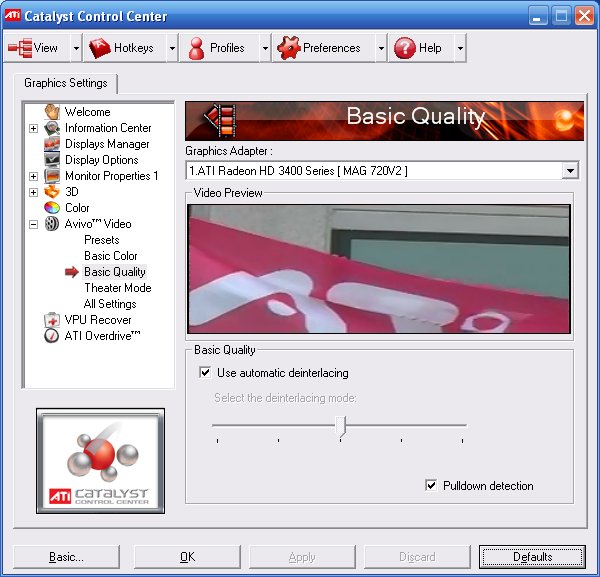A Quick Look at the Radeon HD 3470’s Video Performance

The Radeon HD 3470 is just up from the bottom of the line in the new Radeon HD 3000 series. ATI had press slides saying the 3470 is great for HD and passes the HD HQV tests. So of course I wanted to see for myself. So how does this $70 card work? I’d say quite well. Please note that this not a comprehensive review, but a look at the video performance of the Radeon 3470. Read on for the details.
To get things started I tested in my desktop PC which has a single core CPU. This should let us see if this will be a nice upgrade for those with single-core CPUs.
The specs:
AMD Athlon 64 3700+ (single core socket 939 2.2 GHz)
1GB DDR 400
Windows XP MCE 2005
NVIDIA GeForce 7800GTX or ATI Radeon HD 3470 (Catalyst 8.2)
PowerDVD Ultra 7.3 with latest ver. 3730 patch
The titles I selected were made to stress the decoding abilities.
- Elephant’s Dream is an open source computer animated movie. The clip I used was encoded at 1080p/24 with a constant bitrate of 40Mbit/sec. This is a very high bitrate, and not normally seen, even Blu-ray titles that use MPEG2 are variable bitrate and so only hit 40Mbit for a few seconds at a time.
- The Bourne Ultimatum is an action packed movie with a lot of quick movements, it seems to be quite strenuous to decode. Even when I had the more modern GeForce 8600GT in this system it couldn’t hack it, the GeForce 8600 has partial acceleration for VC-1 whereas the Radeon HD series have full acceleration for the codec.
- Transformers is a pretty typical H.264 (MPEG-4/AVC) title, in general H.264 is known to be harder to decode then the other codecs Blu-ray and HD DVD are allowed to use.
Some baseline performance metrics:
The GeForce 7-series is still quite popular, many users have these in their HTPCs from a few years ago when the 7600GT was a great GPU to have for DVD and basic HDTV watching.
| Title | CPU Usage | Comments |
| High Bitrate MPEG2 — Elephant’s Dream | 42%-69% | Looks good |
| VC-1 — Bourne Ultimatium | 68% -100% | CPU jumps all over from 68% to 100%, usually right at 99%, lots of frames dropped, making it unwatchable. |
| H.264 — Transformers | 91% -100% | Bearly making it, lots of frames dropped but smooths out for a while, and then stutters again, making it unwatchable. |
Now to the Radeon HD 3470…
| Title | CPU Usage | Comments |
| High Bitrate MPEG2 — Elephant’s Dream | 39%-69% | Looks good |
| VC-1 — Bourne Ultimatium | 66%-88% | Smooth, but high CPU usage, Ultimatium is a bitch to decode in my experience. |
| H.264 — Transformers | 50%-72% | Nice and smooth! |
And now, the bigger question, how does the 3470 do at the HQV tests?
HD HQV
| Test | Score | Comments |
| Noise Reduction | 7/25 | Noise is reduced but detail is lost. This is probably the most subjective portion of the tests and really the least important for HD sources. So don’t let this score deter you. |
| Video Resolution Test Pattern | 20/20 | |
| Jaggies | 20/20 | |
| Film Resolution Test Pattern | 25/25 | It passes, but when the clip loops for a split second it has to re-lock on to the 3:2 cadence. |
| Film Resolution Stadium Clip | 10/10 | |
| Total Score | 82/100 | This is a fine score, especially when you figure that of the 75 points that matter the most it gets full scores on those tests. |
HQV
| Test | Score | Comments |
| Color Bar | 10/10 | |
| Jaggies 1 | 5/5 | |
| Jaggies 2 | 5/5 | |
| Flag | 10/10 | |
| Picture Detail | 10/10 | |
| Noise Reduction | 10/10 | |
| Motion Adaptive Nose Reduction | 10/10 | |
| 3:2 Detection (motor speedway) | 5/10 | Lags a bit in catching on to the 3:2 cadence when the clip loops. |
| Film Cadences | 40/40 | |
| Mixed Film/Video Horizontal | 10/10 | |
| Mixed Film/Video vertical | 10/10 | |
| Total Score | 125/130 | Excellent score, really these days it’s hard to mess up standard DVD. |
Misc. Notes about the Radeon HD 3470
The pulldown detection was unchecked by default! NVIDIA now has their inverse telecine box checked in recent drivers.

Manual Deinterlacing modes in CCC — Weave, Bob, Adaptive, Motion Adaptive, Vector Adaptive
PowerDVD’s advanced deinterlacing mode was set for ‘3C’ which is the ATI Vector Adaptive mode, the highest quality mode.
